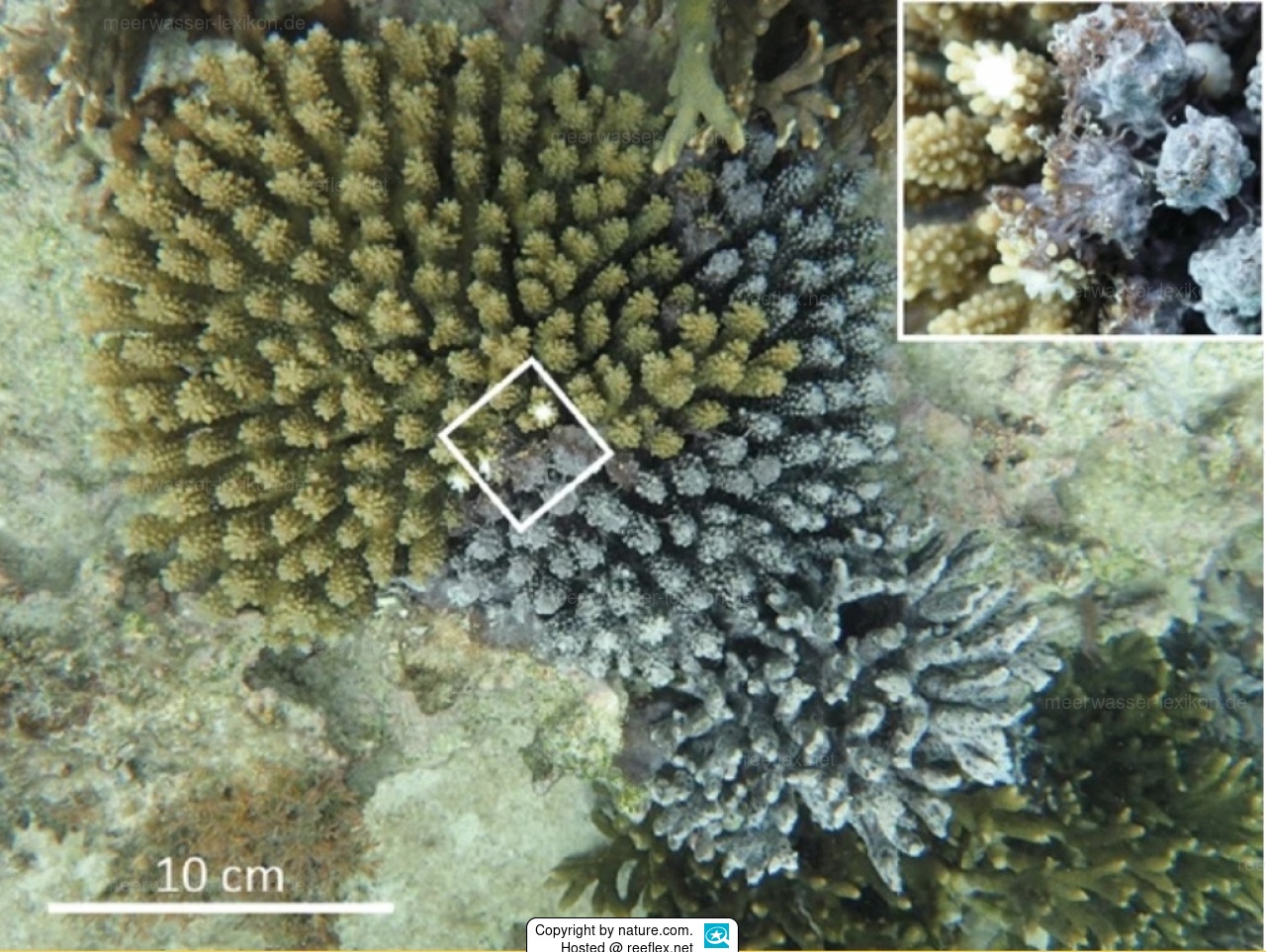Info
Coral reefs today are under ever-increasing man-made pressures such as rising water temperatures, ocean acidification, bleaching due to El Nino, physical/chemical disturbances (by anchors, nets, discharge by sewage, fertilizers and toxins) infectious diseases, oil spills, coral predators and sport activities (diving, snorkeling).
In addition, there is more or less destruction by hurricanes, crown-of-thorns starfish and sponges capable of destroying corals.
Here the Terpios hoshinota from the family of cork sponges is mentioned as an example.
Terpios hoshinota can be recognized by their extensive gray to blackish encrustations on corals, characteristic lobed tylostyle spines, and association with abundant large unicellular cyanobacteria of the type Aphanocaps raspaigella.
The sponge aggressively competes for space by killing and overgrowing living corals and is responsible for the demise of large reef areas, especially in polluted zones near the coast.
The intercellular zoocyanelles make up half or more of the sponge tissue.
Their morphology, determined by electron microscopy observations, is identical to that of symbionts described in two species of an unrelated sponge genus from the Caribbean, Dictyonella.
Around Okinawa in 2021, tiny snails (Joculator sp.) were discovered crawling on the sponge.
There was no direct observation of predation on the sponge by this snail, yet this first report showed a close association between a snail and the sponge Terpios hoshinota.
However, sponges are predicted to be "winners" in future coral reefs, and together with macroalgae, they could replace corals in a changing environment.
It is increasingly likely that some sponges could replace corals, resulting in sponge-dominated reefs.
Changes from coral-dominated to sponge-dominated reefs have been reported from reefs in the Caribbean, Atlantic, Indo-Pacific, and Pacific oceans.
In Wakatobi Marine National Park, Sulawesi, Indonesia, coral cover steadily decreases as sponges increase.
The more the sponge infest the reefs, the lower the usual number of fish that otherwise obligate coral reefs.
A chance to positively influence this alarming development is given to sponge-eating species such as fish and turtles, mollusks such as opisthobranchs/snails, echinoderms such as asteroids, crustaceans such as crabs and shrimps.
In addition, there is more or less destruction by hurricanes, crown-of-thorns starfish and sponges capable of destroying corals.
Here the Terpios hoshinota from the family of cork sponges is mentioned as an example.
Terpios hoshinota can be recognized by their extensive gray to blackish encrustations on corals, characteristic lobed tylostyle spines, and association with abundant large unicellular cyanobacteria of the type Aphanocaps raspaigella.
The sponge aggressively competes for space by killing and overgrowing living corals and is responsible for the demise of large reef areas, especially in polluted zones near the coast.
The intercellular zoocyanelles make up half or more of the sponge tissue.
Their morphology, determined by electron microscopy observations, is identical to that of symbionts described in two species of an unrelated sponge genus from the Caribbean, Dictyonella.
Around Okinawa in 2021, tiny snails (Joculator sp.) were discovered crawling on the sponge.
There was no direct observation of predation on the sponge by this snail, yet this first report showed a close association between a snail and the sponge Terpios hoshinota.
However, sponges are predicted to be "winners" in future coral reefs, and together with macroalgae, they could replace corals in a changing environment.
It is increasingly likely that some sponges could replace corals, resulting in sponge-dominated reefs.
Changes from coral-dominated to sponge-dominated reefs have been reported from reefs in the Caribbean, Atlantic, Indo-Pacific, and Pacific oceans.
In Wakatobi Marine National Park, Sulawesi, Indonesia, coral cover steadily decreases as sponges increase.
The more the sponge infest the reefs, the lower the usual number of fish that otherwise obligate coral reefs.
A chance to positively influence this alarming development is given to sponge-eating species such as fish and turtles, mollusks such as opisthobranchs/snails, echinoderms such as asteroids, crustaceans such as crabs and shrimps.







 nature.com
nature.com




